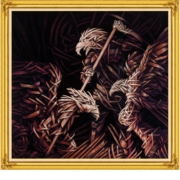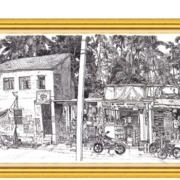Market trends and reality: two examples
Art investors sooner or later come across invariably upbeat reports on trends in the art market. Consider these carefully in light of the source of each report just as you would similar statements by analysts extolling the potential of other investment vehicles.
In general, reports on trends in the art market have limited value for the investor. It is easy to be seduced by the statement that the number of works of contemporary art sold at auction in the last decade has quadrupled. There is even better news. The prices for contemporary art have risen by 34 percent. (All statistics taken from the white paper Contemporary Art Market: The Artprice Annual Report for 2013, available at artprice.com.) However, it is important to be aware that this figure includes major pieces by blue-chip artists, such a Jeff Koons, Takashi Murakami and Anish Kapoor. The hammer price for a very select group of art stars has soared into the stratosphere, but this group is very small indeed.
The average annual price increase for the works of non-star and emerging artists is much less. Investors in works by emerging artists must look deeper into the art market and be skeptical of reported trends. The statistics get skewed by the stellar winning bids for works by the likes of American painter John Currin (b. 1962). In 2013, 13 of his pictures were auctioned for a total of more than nine million USD. This was a rare and quite unpredictable event in the art market, making it newsworthy.
A look at a single work by American art-star Jeff Koons (b. 1955) can be instructive for those bowled over by the market for his works. In 2013, 48 works by Koons sold for a total of more than 50 million. Of these, a few sold for several million dollars, while the others had much more modest knockdown prices.
At a sale on March 7, 2014, Koons’ ceramic Balloon Dog (Red), number 131 of an edition of 2,300, sold for $22,500. This appears to be a good return on an investment held by the collector for 18 years. If one considers the transaction in a little more detail, the return on investment is not all that it might seem at first glance. The process of calculating a return on investment is a little complicated, but it is well worth understanding how it is done.
First the sale price must be discounted by the 25 percent buyer’s premium retained by the auction house. In this case of Koons’ Balloon Dog (Red), it was 25 percent of $22,500. So from the transaction, the seller’s account was credited with $18,000. From this was deducted the auction house seller’s premium or commission of 20 percent. Thus, the seller pocketed $14,400 from the sale. In calculating the return on investment we need to know the cost base or book value of the work. This is particularly difficult as commercial galleries are notoriously tight-lipped on sale prices. It is possible that the owner of the single piece from the large edition of Koons’ Balloon Dog (Red) acquired it for something in the range of $2,000. The return on the 18-year investment ($14,400 – $2,000) may have been around 34 percent per annum. But, there is another way of looking at this. If we put $14,400 actual return from the sale into a calculator at usinflationcalculator.com, we find that this sum equals $9,499 in 1996 dollars. Over 18 years, the real/uninflated annual rate of return for this investment, was about 26 percent. Koons’ Balloon Dog (Red) was a very good investment no matter how it is calculated, but not as stunning as it may first appear.
Only a few lucky investors had the foresight – or available cash – a couple of decades ago to invest in a work by Jeff Koons or one of his colleagues who now happen to top the art index. It is a question of predicting future demand for the works or a particular artist.
Currently, 68 percent of contemporary works sell at auction for under $7,000. They are not the works of so-called “market leaders.” Consider a single work, chosen more or less at random, as an example – a 10-inch X 96-inch oil on canvas, Lamay Bridge, (1987) by the American artist Woody Gwyn (b. 1944). In February 2010, it sold at auction in San Francisco from the collection of a law firm, fetching $4,575. Subtracting the 25 percent buyer’s premium, the return to the seller was $3,432. Because this work was part of a large consignment by the law firm, the auction house seller’s commission was probably discounted to around 10 percent. The law firm likely received in the vicinity of $3,089 from the sale of this work that was originally acquired in 1987 from a Santa Fe gallery. The price at the time might have been about $500. The difference between the book value of the artwork and the return from its sale ($3,089 – $500) shows a $2,589 capital gain. The annual rate of return on investment was in the range of 23 percent. But, when we put the $3,089 return from the sale of the work into an inflation calculator, this sum is equivalent to $1,609 in 1987 dollars. Subtract the cost of acquiring the work originally and the uninflated gains from the purchase are $1,109, or ($1,109/22 years) $50 per annum or 10 percent.
These two examples show the differences in return on investment. If a collector with a small budget is lucky – or clever enough – to acquire a work by an emerging artist who eventually rises to the top of the market, the rewards can be substantial. This applies equally to investment in works by skilled artists who do not achieve a mega-star status. In both cases, the risk must be considered in relation to a best guess at future demand and the potential rate of return.
The good news must be tempered with an important warning. All the statistics on which art market trends are calculated are based on actual public sales. No one reports on the huge number of works that are put up for auction and fail to find a buyer. Depending on the prevailing economic conditions it is not unknown, for as many as half the works in a sale to be bought in or remain unsold.
In the art market, statistical trends are an imperfect guide at best. They are not of much use in helping an art investor determine risk. In the case of the acquisition of art for investment purposes, the eye is invariably mightier than the math. Even if capital gains are not forthcoming, a well-chosen work will delight the owner. There is no way to put a monetary value on this, so it’s not subject to the vagaries of statistical analysis.
By Dr. Alan McNairn








